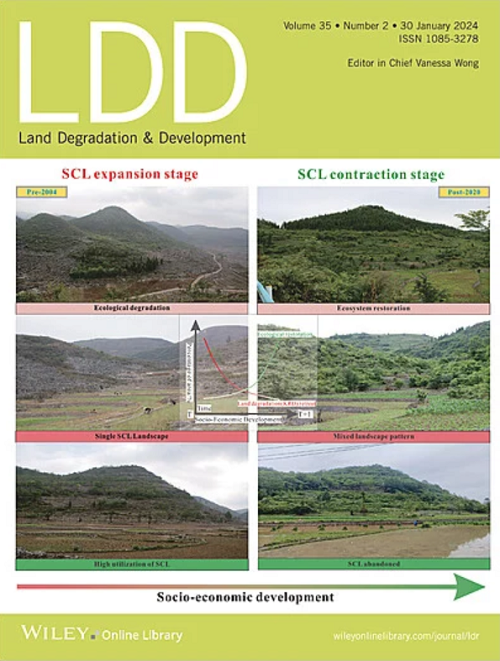Soil Conservation Assessment by SWAT With Improved Sediment Module and Driving Mechanism Analysis of Its Changes: A Case Study of the Jinghe River Basin, China
IF 3.6
2区 农林科学
Q2 ENVIRONMENTAL SCIENCES
引用次数: 0
Abstract
Globally, the importance of soil conservation (SC) has been increasingly recognized, with a growing demand for the use of more accurate soil erosion models to assess soil conservation and investigate its driving mechanisms. This is essential to meet the requirements of land management and ecological restoration. This study developed a framework for calibrating the sediment module K, C, and P factors of the SWAT model using soil sampling data and remote sensing measurements. Taking the Jinghe River Basin as an example, the optimized model was utilized to assess the spatiotemporal characteristics of soil conservation. Furthermore, this study examined the driving mechanisms of changes in soil conservation by analyzing the relationship between potential and actual soil erosion. The findings demonstrate that calibrating the model using measured data significantly enhances its applicability. Under the combined influence of climate change and human activities, potential soil erosion markedly increased from 2000 to 2020, whereas actual erosion generally decreased, resulting in an overall increase in soil conservation. The changes in soil conservation were primarily driven by climate change‐dominated increase (CCI) and ecological restoration‐dominated increase (ERI). This study is significant for improving soil erosion mechanism models, understanding the regional baseline of soil conservation, and clarifying the driving mechanisms of soil conservation changes. It offers new insights and technical support for soil erosion research and regional management.基于改进泥沙模型的SWAT水土保持评价及其变化驱动机制分析——以荆河流域为例
在全球范围内,土壤保持的重要性日益被认识到,人们越来越需要使用更准确的土壤侵蚀模型来评估土壤保持并研究其驱动机制。这是满足土地管理和生态恢复要求的必要条件。本研究开发了一个利用土壤采样数据和遥感测量来校准SWAT模型中沉积物模块K、C和P因子的框架。以泾河流域为例,利用优化后的模型对流域土壤保持的时空特征进行了评价。此外,通过分析潜在侵蚀与实际侵蚀的关系,探讨了土壤保持变化的驱动机制。研究结果表明,利用实测数据对模型进行校正可以显著提高模型的适用性。2000 - 2020年,在气候变化和人类活动的共同影响下,潜在土壤侵蚀显著增加,而实际土壤侵蚀总体减少,土壤保持总体增加。土壤保持变化主要由气候变化主导的增加(CCI)和生态恢复主导的增加(ERI)驱动。该研究对于完善土壤侵蚀机制模型,了解区域土壤保持基线,阐明土壤保持变化的驱动机制具有重要意义。它为土壤侵蚀研究和区域管理提供了新的见解和技术支持。
本文章由计算机程序翻译,如有差异,请以英文原文为准。
求助全文
约1分钟内获得全文
求助全文
来源期刊

Land Degradation & Development
农林科学-环境科学
CiteScore
7.70
自引率
8.50%
发文量
379
审稿时长
5.5 months
期刊介绍:
Land Degradation & Development is an international journal which seeks to promote rational study of the recognition, monitoring, control and rehabilitation of degradation in terrestrial environments. The journal focuses on:
- what land degradation is;
- what causes land degradation;
- the impacts of land degradation
- the scale of land degradation;
- the history, current status or future trends of land degradation;
- avoidance, mitigation and control of land degradation;
- remedial actions to rehabilitate or restore degraded land;
- sustainable land management.
 求助内容:
求助内容: 应助结果提醒方式:
应助结果提醒方式:


